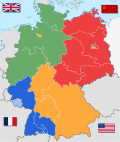Allied-occupied Germany
Germany Deutschland (German) | |||||||||||||
|---|---|---|---|---|---|---|---|---|---|---|---|---|---|
| 1945–1949 | |||||||||||||
|
The C-Pennant | |||||||||||||
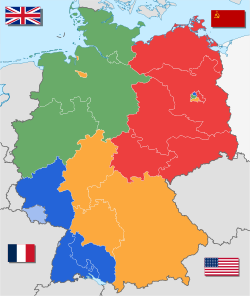 Germany from 17 December 1947 to 23 May 1949 | |||||||||||||
| Status | Military occupation | ||||||||||||
| Capital |
52°31′N 13°23′E / 52.517°N 13.383°E Saar Protectorate (de facto not a part of Germany) French occupation zone British occupation zone[a] American occupation zone Soviet occupation zone[b] | ||||||||||||
| Common languages | |||||||||||||
| Governors (1945) | |||||||||||||
• British zone | Bernard Montgomery | ||||||||||||
• American zone | Dwight D. Eisenhower | ||||||||||||
• French zone | Jean de Lattre de Tassigny | ||||||||||||
• Soviet zone | Georgy Zhukov | ||||||||||||
| Historical era | Saar Protectoratea | 17 December 1947 | |||||||||||
| 23 May 1949 | |||||||||||||
• East Germanyb | 7 October 1949 | ||||||||||||
| c | 15 March 1991 | ||||||||||||
| Population | |||||||||||||
• 1945 | 64,260,000 | ||||||||||||
• 1949 | 68,080,000 | ||||||||||||
| Currency |
| ||||||||||||
| |||||||||||||
| |||||||||||||
Berlin | |||||||||||||
| History of Germany |
|---|
 |
The entirety of Germany was
Deviating from the occupation zones planned according to the London Protocol in 1944, at Potsdam, the United States, United Kingdom and the Soviet Union approved the detachment from Germany of the territories east of the Oder–Neisse line, with the exact line of the boundary to be determined in a final German peace treaty. This treaty was expected to confirm the shifting westward of Poland's borders, as the United Kingdom and United States committed themselves to support the permanent incorporation of eastern Germany into Poland and the Soviet Union. From March 1945 to July 1945, these former eastern territories of Germany had been administered under Soviet military occupation authorities, but following the Potsdam Agreement they were handed over to Soviet and Polish civilian administrations and ceased to constitute part of Allied-occupied Germany.
In the closing weeks of fighting in Europe, United States forces had pushed beyond the agreed boundaries for the future zones of occupation, in some places by as much as 320 km (200 miles). The so-called
Occupation zones
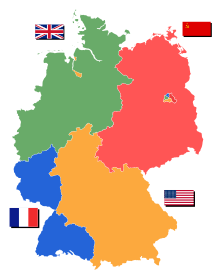
American zone
The American zone in
The ports of
- Bavaria 8.7 million
- Hesse 3.97 million
- Württemberg-Baden 3.6 million
- Bremen 0.48 million[4]
The headquarters of the
Following the complete closure of all Nazi German media, the launch and operation of completely new newspaper titles began by licensing carefully selected Germans as publishers. Licenses were granted to Germans not involved in Nazi propaganda to establish those newspapers, including
British zone
By May 1945 the British and Canadian Armies had liberated the Netherlands and had conquered Northern Germany. The Canadian forces went home following the German surrender, leaving Northern Germany to be occupied by the British.
The British Army of the Rhine was formed on 25 August 1945 from the British Liberation Army.[5]
In July the British withdrew from
Within the British zone of occupation, the CCG/BE re-established the city of Hamburg as a German state, but with borders that had been drawn by the Nazi government in 1937. The British also created the new German states of:
- Schleswig-Holstein – emerging in 1946 from the Prussian Province of Schleswig-Holstein;
- Lower Saxony – the merger of Brunswick, Oldenburg, and Schaumburg-Lippe with the state of Hanover in 1946; and
- North Rhine-Westphalia – the merger of Lippe with the Prussian provinces of the Rhineland (northern part) and Westphalia – during 1946–47.
Also in 1947, the American zone of occupation being inland had no port facilities – thus the Free Hanseatic City of Bremen and Bremerhaven became exclaves within the British zone.
At the end of October 1946, the British zone had a population of:
- North Rhine-Westphalia 11.7 million
- Lower Saxony 6.2 million
- Schleswig-Holstein 2.6 million
- Hamburg 1.4 million[4]
The British headquarters were originally based in Bad Oeynhausen from 1946, but in 1954 it was moved to Mönchengladbach where it was known as JHQ Rheindahlen.
Another special feature of the British zone was the enclave of
-
Royal Air Force's Malcolm Club in Schleswig, formerly the Stadt Hamburg Hotel in late 1945
-
British armoured car, at the Brandenburg Gate in Berlin, 1950
Belgian, Polish and Norwegian zones
Army units from other countries were stationed within the British occupation zone.
- The Belgians were allocated a territory which was garrisoned by their troops.[6] The zone formed a 200 kilometres (120 mi) strip from the Belgian-German border at the south of the British zone, and included the important cities of Cologne and Aachen. The Belgian army of occupation in Germany (known as the Belgian Forces in Germany from 1951) became autonomous in 1946 under the command, initially, of Jean-Baptiste Piron.[7] Belgian soldiers remained in Germany until 31 December 2005.[8]

Belgian occupation sub-zone of Germany
- Polish units mainly from Polish government in exile. The administrative centre of the Polish occupation zone was the city of Haren the German population of which was temporarily removed. The city was renamed Maczków (after Stanisław Maczek) from 1945 to 1947. Once the British recognised the pro-Soviet government in Poland, and withdrew recognition from the London-based Polish government in exile, the Emsland zone became more of an embarrassment. Polish units within the British Army were demobilised in June 1947. The expelled German populations were allowed to return and the last Polish residents left in 1948.[citation needed]
- In 1946, the Norwegian Brigade Group in Germany had 4,000 soldiers in Hanover; amongst whom was future Chancellor Willy Brandt (then a Norwegian citizen) as press attaché.
- In 1947 (during summer), a It remained stationed at Itzehoe, under the name of The Danish Command in Germany, until 1958.
- The London conference of 23 April 1949, during the Bakker-Schut Plan. So, at 12 noon that day, Dutch troops moved to occupy an area of 69 km2 (17,000 acres), the most relevants parts were Elten (near Emmerich am Rhein) and Selfkant. Many other small border corrections were done, mostly in the vicinity of Arnhem and Dinxperlo, which also were part of this small Dutch sub-zone of occupation.
French zone
The
The French zone of occupation included the
At the end of October 1946, the French zone had a population of:
- Rheinland Pfalz 2.7 million
- Baden (South Baden) 1.2 million
- Württemberg-Hohenzollern 1.05 million
(The Saar Protectorate had a further 0.8 million.)[4]
Luxembourg zone
From November 1945, Luxembourg was allocated a zone within the French sector.
Soviet zone
The Soviet occupation zone incorporated Thuringia, Saxony, Saxony-Anhalt, Brandenburg and Mecklenburg.[citation needed] The Soviet Military Administration was headquartered in Berlin-Karlshorst, which also came to house the chief rezidentura of Soviet intelligence in Germany.[15]
At the end of October 1946, the Soviet zone had a population of:
- Saxony: 5.5 million
- Saxony-Anhalt: 4.1 million
- Thuringia: 2.9 million
- Brandenburg: 2.5 million
- Mecklenburg: 2.1 million[4]
Berlin
While located wholly within the Soviet zone, because of its symbolic importance as the nation's capital and seat of the former Nazi government, the city of Berlin was jointly occupied by the Allied powers and subdivided into four sectors. All four occupying powers were entitled to privileges throughout Berlin that were not extended to the rest of Germany – this included the Soviet sector of Berlin, which was legally separate from the rest of the Soviet zone.
At the end of October 1946, Berlin had a population of:
- Western sectors 2.0 million
- Soviet sector 1.1 million[4]
Lost territory
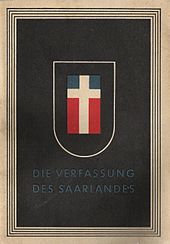
In 1945
Saarland, an area in the French occupation zone, was separated from Allied-occupied Germany to become a French protectorate with its constitution took effect on 17 December 1947, however the separation was opposed by the Soviet Union and Germans here were not expelled.
Population
In October 1946, the population of the various zones and sectors was as follows:[4]
| State, sector, or other territory | Zone | Population |
|---|---|---|
| Bavaria | American | 8.7 million |
| Hesse | American | 3.97 million |
| Württemberg-Baden | American | 3.6 million |
| Bremen | American | 0.48 million |
| North Rhine-Westphalia | British | 11.7 million |
| Lower Saxony | British | 6.2 million |
| Schleswig-Holstein | British | 2.6 million |
| Hamburg | British | 1.4 million |
| Rhineland-Palatinate | French | 2.7 million |
| South Baden | French | 1.2 million |
| Württemberg-Hohenzollern | French | 1.05 million |
| Saxony | Soviet | 5.5 million |
| Saxony-Anhalt | Soviet | 4.1 million |
| Thuringia | Soviet | 2.9 million |
| Brandenburg | Soviet | 2.5 million |
| Mecklenburg-Vorpommern | Soviet | 2.1 million |
| Berlin (western sectors) | American, British, French | 2.0 million |
| Berlin (Soviet sector) | Soviet | 1.1 million |
Governance and the emergence of two German states
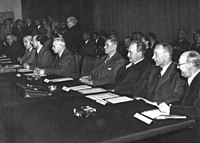
The original Allied plan to govern Germany as a single unit through the Allied Control Council de facto broke down on 20 March 1948 (restored on 3 September 1971) in the context of growing tensions between the Allies, with Britain and the US wishing cooperation, France obstructing any collaboration in order to partition Germany into many independent states, and especially: the Soviet Union unilaterally implementing from early on elements of a Marxist political-economic system (enforced redistribution of land, nationalisation of businesses). Another dispute was the absorption of post-war expellees. While the UK, the US and the Soviet Union had agreed to accept, house and feed about six million expelled German citizens from former eastern Germany and four million expelled and denaturalised Czechoslovaks, Poles, Hungarians and Yugoslavs of German ethnicity in their zones, France generally had not agreed to the expulsions approved by the Potsdam agreement (a decision made without input from France). Therefore, France strictly refused to absorb war refugees who were denied return to their homes in seized eastern German territories or destitute post-war expellees who had been expropriated there, into the French zone, let alone into the separated Saar protectorate.[16] However, the native population, returning after Nazi-imposed removals (e.g., political and Jewish refugees) and war-related relocations (e.g., evacuation from air raids), were allowed to return home in the areas under French control. The other Allies complained that they had to shoulder the burden to feed, house and clothe the expellees who had to leave their belongings behind.
In practice, each of the four occupying powers wielded government authority in their respective zones and carried out different policies toward the population and local and state governments there. A uniform administration of the western zones evolved, known first as the
In the west, the occupation continued until 5 May 1955, when the
A similar situation occurred in East Germany. The GDR was founded on 7 October 1949. On 10 October the
Despite the grants of general sovereignty to both German states in 1955, full and unrestricted sovereignty under international law was not enjoyed by any German government until after the
A 1956 plebiscite ended the French administration of the Saar protectorate, and it joined the Federal Republic as Saarland on 1 January 1957, becoming its tenth state.
The city of Berlin was not part of either state and de jure continued to be under Allied occupation of the four countries until the reunification of Germany in October 1990. For administrative purposes, the three western sectors of Berlin were merged into the entity of West Berlin being de facto part of the FRG. The Soviet sector became known as East Berlin and while not recognised by the Western powers as a part of East Germany, the GDR declared it its capital (Hauptstadt der DDR).
Occupation policy
Allied aims with respect to postwar Germany were first laid out at the
US occupation policy
The US originally considered a punitive approach championed by

Initially, the US was extremely rigorous in its efforts to prevent fraternization with German civilians. US soldiers were forbidden to shake hands with Germans, visit their homes, play games or sports with them, exchange gifts, take part in social events, or walk in the streets with them. How strictly this policy was applied varied from place to place, but in many places the restrictions were frequently ignored, as a result of which the policy was quickly abandoned.[22] Germans were also prohibited from inhabiting any part of a building in which US soldiers were housed, leading to large numbers of Germans being ejected from their homes.[22]
British occupation policy
British occupation policy was similar to that of the United States, but with a greater focus on economic problems. The
To further the long-term aim of democratization, the British implemented government modeled on the UK system, placing heavy emphasis on local level democracy. The goal was to create a British-style administration with employees who viewed themselves as public servants, on the basis that this would help to reeducate Germans to democratic modes of thought. To that end the British introduced new local government structures, including a nonpolitical position similar to the English town clerk ("city director") that replaced the office of mayor.[20]
In general, the British believed strongly in reeducation as a means to achieve democracy, which led them to prioritize the reestablishment of schooling and university education in their zone.[23]
French occupation policy
The French were less concerned with improving Germany's moral and civic character, focusing instead on ensuring France's future security and utilizing the resources of
On the economic front, the French seized the opportunity to extract coal and steel resources from the Saar region, fusing it with France in a customs and currency union and encouraging the development of export industries. As a result, the French managed to extract a surplus from their occupation zone, and prevented it from becoming a financial liability the way the British and American zones were to their respective occupying powers.[20]
Soviet occupation policy
Soviet aims in Germany were similar to those of the French, with the primary goals being to prevent future aggression by Germany and to extract reparations.[20]
Political activity in the
Soviet occupation authorities also executed a rigorous program of land reform, expropriating large landed estates and imposing direct control over much of the economic activity in the zone.[20] They closed major banks and insurance companies in July 1945, and seized property formerly belonging to the German state, Wehrmacht, Nazi party, and Nazi organizations.[20]
The Soviets used suspicion of supposed Werwolf activity to tighten police control and secure forced labor.[22]
Conditions in the occupation zones
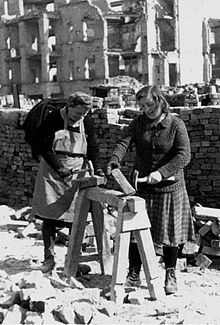
The food situation in occupied Germany was initially very dire. By the spring of 1946 the official ration in the American zone was no more than 1,275 calories (5,330 kJ) per day, with some areas probably receiving as little as 700 calories (2,900 kJ) per day. In the British zone the food situation was dire, as found during a visit by the British (and Jewish) publisher Victor Gollancz in October and November 1946. In Düsseldorf the normal 28-day allocation should have been 1,548 calories (6,480 kJ) including 10 kilograms (22 lb) of bread, but as there was limited grain the bread ration was only 8.5 kilograms (19 lb). However, as there was only sufficient bread for about 50% of this "called up" ration, the total deficiency was about 50%, not 15% as stated in a ministerial reply in the British Parliament on 11 December. So only about 770 calories (3,200 kJ) would have been supplied, and he said the German winter ration would be 1,000 calories (4,200 kJ) as the recent increase was "largely mythical". His book includes photos taken on the visit and critical letters and newspaper articles by him published in several British newspapers; The Times, the Daily Herald, the Manchester Guardian, etc.[24]
Some occupation soldiers took advantage of the desperate food situation by exploiting their ample supply of food and cigarettes (the currency of the black market) to get to the local German girls as what became known as frau bait (The New York Times, 25 June 1945). Some soldiers still felt the girls were the enemy, but used them for sex nevertheless.[25]
The often destitute mothers of the resulting children usually received no child support. In the earliest stages of the occupation, U.S. soldiers were not allowed to pay maintenance for a child they admitted having fathered, since to do so was considered "aiding the enemy". Marriages between white U.S. soldiers and Austrian women were not permitted until January 1946, and with German women until December 1946.[25]
The children of African-American soldiers, commonly called Negermischlinge[26] ("Negro half-breeds"), comprising about three percent of the total number of children fathered by GIs, were particularly disadvantaged because of their inability to conceal the foreign identity of their fathers. For many white U.S. soldiers of this era, miscegenation even with an "enemy" white population was regarded as an intolerable outrage. African-American soldiers were therefore reluctant to admit to fathering such children since this would invite reprisals and even accusations of rape, a crime which was much more aggressively prosecuted by military authorities against African-Americans compared with Caucasian soldiers, much more likely to result in a conviction by court-martial (in part because a German woman was both less likely to acknowledge consensual sexual relations with an African-American and more likely to be believed if she alleged rape against an African-American) and which carried a potential death sentence. Even in the rare cases where an African-American soldier was willing to take responsibility for fathering a child, until 1948 the U.S. Army prohibited interracial marriages.[26] The mothers of the children would often face particularly harsh ostracism.[27]
Between 1950 and 1955, the Allied High Commission for Germany prohibited "proceedings to establish paternity or liability for maintenance of children."[26] Even after the lifting of the ban West German courts had little power over American soldiers.
While Allied servicemen were ordered to obey local laws while in Germany, soldiers could not be prosecuted by German courts for crimes committed against German citizens except as authorised by the occupation authorities. Invariably, when a soldier was accused of criminal behaviour the occupation authorities preferred to handle the matter within the military justice system. This sometimes led to harsher punishments than would have been available under German law – in particular, U.S. servicemen could be executed if court-martialed and convicted of rape.[27] See United States v. Private First Class John A. Bennett, 7 C.M.A. 97, 21 C.M.R. 223 (1956).
Insurgency
The last Allied war advances into Germany and Allied occupation plans were affected by rumors of the Nazi
Expulsion policy
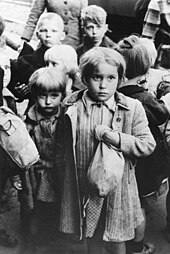
The
Hungary, which had been allied with Germany and whose population was opposed to an expulsion of the German minority, tried to resist the transfer. Hungary had to yield to the pressure exerted mainly by the Soviet Union and by the Allied Control Council.[30] Millions of people were expelled from former eastern territories of Germany, Poland, Czechoslovakia, Hungary and elsewhere to the occupation zones of the UK, US, and USSR, which agreed in the Potsdam Agreement to absorb the post-war expellees into their zones. Many remained in refugee camps for a long time. Some Germans remained in the Soviet Union and were used for forced labour for a period of years.
France was not invited to the Potsdam Conference. As a result, it chose to adopt some decisions of the Potsdam Agreements and to dismiss others. France maintained the position that it did not approve post-war expulsions and that therefore it was not responsible to accommodate and nourish the destitute expellees in its zone. While the few war-related refugees who had reached the area to become the French zone before July 1945 were taken care of, the French military government for Germany refused to absorb post-war expellees deported from the East into its zone. In December 1946, the French military government for Germany absorbed into its zone German refugees from Denmark, where 250,000 Germans had found a refuge from the Soviets by sea vessels between February and May 1945.[16] These clearly were war-related refugees from the eastern parts of Germany however, and not post-war expellees.
Military governors and commissioners
See also
- Allied-occupied Austria
- German-occupied Europe
- History of Germany since 1945
- Interzonal traffic
- Allied-occupied Japan
Notes
References
- ^ States, United (1968). Treaties and Other International Agreements of the United States of America, 1776-1949: Multilateral, 1931-1945. Department of State. Archived from the original on 21 January 2023. Retrieved 24 June 2021.
- ^ "What Is to Be Done?". Time. 9 July 1945. Archived from the original on 16 February 2023. Retrieved 17 April 2020.
- ^ Knowles, Chris (29 January 2014). "Germany 1945–1949: a case study in post-conflict reconstruction". History & Policy. Archived from the original on 9 June 2023. Retrieved 19 July 2016.
- ^ Statistisches Bundesamt. Wiesbaden.
- ^ "British Army of the Rhine". BAOR Locations. Archived from the original on 18 September 2015. Retrieved 1 November 2015.
- ^ Brüll, Christoph (2011). "Entre ressentiment et ré-éducation, L'Armée belge d'Occupation et les Allemands, 1945–1952" (PDF). Cahiers d'Histoire du Temps Présent. 23: 55–56. Archived (PDF) from the original on 14 October 2013. Retrieved 6 July 2013.
- ^ Brüll, pp. 55–94.
- ^ Brüll, p. 55.
- ^ "Agreement concerning the participation of a Danish contingent in the occupation of Germany. Signed at Copenhagen, April 22, 1947". Archived from the original on 18 January 2023. Retrieved 18 January 2023.
- ^ "The Danish Brigade in Germany 1947–1958" (PDF). Archived (PDF) from the original on 21 March 2023. Retrieved 18 January 2023.
- ^ Reinisch, Jessica (2013). The Perils of Peace. OUP. p. 261.
- ^ de Gaulle, Charles (1959). Mémoires de guerre : Le Salut 1944–1946. Plon. pp. 170, 207.
- S2CID 210491528.
- ^ a b c "L'Armée luxembourgeoise après la libération (1944–1967)". Armée.lu. Archived from the original on 30 July 2013. Retrieved 6 July 2013.
- ISBN 978-0-300-07871-8.
- ^ a b Cf. the report of the Central State Archive of Rhineland-Palatinate on the first expellees arriving in that state in 1950 from other German states in the former British or American zone: "Beyond that [the fact, that until France took control of her zone west only few eastern war refugees had made it into her zone] already since summer 1945 France refused to absorb expellee transports in her zone. France, who had not participated in the Potsdam Conference, where the expulsions of eastern Germans had been decided, and who therefore did not feel responsible for the ramifications, feared an unbearable burden for its zone anyway strongly smarting from the consequences of the war." N.N., "Vor 50 Jahren: Der 15. April 1950. Vertriebene finden eine neue Heimat in Rheinland-Pfalz" Archived 31 July 2013 at the Wayback Machine, on: Rheinland-Pfalz Landesarchivverwaltung Archived 25 April 2009 at the Wayback Machine, retrieved on 4 March 2013.
- ^ "Document 500: Communiqué Issued at the End of the Conference". Foreign Relations of the United States: The Conferences at Malta and Yalta 1945. U.S. Department of State. 12 February 1945. Archived from the original on 6 August 2023.
- ISBN 978-1-84983-201-4. chpt. 10, "Visions of a New World".
- ISBN 978-0-465-00337-2.
- ^ a b c d e f g h i j k Bessel 2010, chpt. 10.
- ^ MacDonogh 2007, p. 7.
- ^ a b c d Bessel 2010, chpt. 7.
- ^ MacDonogh 2007, pp. 253–254.
- ^ Gollancz, Victor (1947). In Darkest Germany. Victor Gollancz, London. pp. 116, 125–6.
- ^ S2CID 145470893.
- ^ a b c Children of the Enemy Archived 3 June 2008 at the Wayback Machine by Mary Wiltenburg and Marc Widmann, Der Spiegel, 2 January 2007
- ^ a b Hitchcock, William I. (2008). The Bitter Road to Freedom. New York: Free Press.
- ^ Benjamin, Daniel (29 August 2003). "Condi's Phony History". Slate magazine. Archived from the original on 20 July 2008. Retrieved 8 July 2008.
- ISBN 978-0-8020-0862-6.
- ^ The Expulsion of the 'German' Communities from Eastern Europe at the End of the Second World War Archived 1 October 2009 at the Wayback Machine Steffen Prauser and Arfon Rees, European University Institute, Florence, Department of history and civilization
Further reading
- Bark, Dennis L., and David R. Gress. A History of West Germany Vol 1: From Shadow to Substance, 1945–1963 (1992)
- Bessel, Richard. Germany 1945: from war to peace (Simon and Schuster, 2012)
- Campion, Corey. "Remembering the" Forgotten Zone": Recasting the Image of the Post-1945 French Occupation of Germany." French Politics, Culture & Society 37.3 (2019): 79-94.
- Erlichman, Camilo, and Knowles, Christopher (eds.). Transforming Occupation in the Western Zones of Germany: Politics, Everyday Life and Social Interactions, 1945-55 (Bloomsbury, 2018). ISBN 978-1-350-04923-9
- Golay, John Ford. The Founding of the Federal Republic of Germany (University of Chicago Press, 1958)
- Jähner, Harald. Aftermath: Life in the Fallout of the Third Reich, 1945-1955 (2022) excerpt
- Jarausch, Konrad H.After Hitler: Recivilizing Germans, 1945–1995 (2008)
- Junker, Detlef, ed. The United States and Germany in the Era of the Cold War (2 vol 2004), 150 short essays by scholars covering 1945–1990 excerpt and text search vol 1; excerpt and text search vol 2
- Knowles, Christopher. "The British Occupation of Germany, 1945–49: A Case Study in Post-Conflict Reconstruction." The RUSI Journal (2013) 158#6 pp: 84–91.
- Knowles, Christopher. Winning the Peace: The British in Occupied Germany, 1945-1948, (Bloomsbury Academic, 2017)
- Main, Steven J. "The Soviet Occupation of Germany. Hunger, Mass Violence and the Struggle for Peace, 1945–1947." Europe-Asia Studies (2014) 66#8 pp: 1380–1382.
- Phillips, David. Educating the Germans: People and Policy in the British Zone of Germany, 1945-1949 (2018) 392 pp. online review
- Schwarz, Hans-Peter. Konrad Adenauer: A German Politician and Statesman in a Period of War, Revolution and Reconstruction (2 vol 1995) full text vol 1 Archived 28 June 2011 at the Wayback Machine
- Taylor, Frederick. Exorcising Hitler: the occupation and denazification of Germany (Bloomsbury Publishing, 2011)
- Weber, Jurgen. Germany, 1945–1990 (Central European University Press, 2004) online edition
Primary sources and historiography
- Andrews, Ernest A.; Hurt, David B. (2022). A Machine Gunner's War: From Normandy to Victory with the 1st Infantry Division in World War II. Philadelphia & Oxford: Casemate. ISBN 978-1636241043.
- Beate Ruhm Von Oppen, ed. Documents on Germany under Occupation, 1945–1954 (Oxford University Press, 1955) online
- Clay, Lucius D. The papers of General Lucius D. Clay: Germany, 1945–1949 (2 vol. 1974)
- Miller, Paul D. "A bibliographic essay on the Allied occupation and reconstruction of West Germany, 1945–1955." Small Wars & Insurgencies (2013) 24#4 pp: 751–759.
External links
- The short film A DEFEATED PEOPLE (1946) is available for free viewing and download at the Internet Archive.
- Civil Affairs In Germany (1945) is available for free viewing and download at the Internet Archive
- The Struggle for Germany and the Origins of the Cold War by Melvyn P. Leffler





